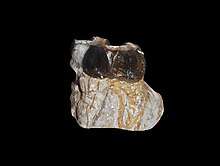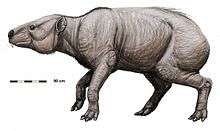Titanohyrax
Titanohyrax is an extinct genus of large to very large hyrax from the Eocene and Oligocene. Specimens have been discovered in modern-day Algeria, Tunisia and Egypt. Some species, like T. ultimus, are estimated to be as large as a rhinoceros. Titanohyrax species are still poorly known due to their rarity in the fossil record.
| Titanohyrax | |
|---|---|
 | |
| Teeth | |
| Scientific classification | |
| Kingdom: | |
| Phylum: | |
| Class: | |
| Order: | |
| Family: | |
| Subfamily: | †Titanohyracinae |
| Genus: | †Titanohyrax Matsumoto, 1922[1] |
| Type species | |
| Titanohyrax andrewsi | |
| Species | |
| |

Titanohyrax is unusual among the numerous Paleogene hyracoids by its lophoselenodont teeth (having teeth that are lophodont and selenodont, fully molariform premolars, and relatively high-crowned cheek teeth. This suggests the genus had a folivorous diet.[2]
The genus was first described by in 1922 for the species T. ultimus from the early Oligocene of the Jebel Qatrani Formation, Fayum Depression, Egypt.[3] The author described it as an “extremely gigantic species, being the largest of all the hyracoids hitherto known” - estimates of body mass range from 600-1300 kg.[4] T. tantulus is the smallest Titanohyrax species known, with a body mass of around 23 kg.[4]
References
- Matsumoto, H., 1922. Megalohyrax, Andrews and Titanohyrax, gen. nov. A revision of the genera of hyracoids from the Fayum, Egypt. Proceedings of the Zoological Society 1921, 839-850
- Rasmussen, D. T., 1989. The evolution of the Hyracoidea: a review of the fossil evidence. In: Prothero, D.R., Schoch, R.M. (Eds.), The Evolution of Perissodactyls. Oxford University Press, New York, pp. 57-78.
- Court, N.; Hartenberger, J. (1992). "A new Species of the Hyracoid Mammal Titanohyrax from the Eocene of Tunisia" (PDF). Palaeontology. 35 (2): 309–317.
- Tabuce, R. 2016. A mandible of the hyracoid mammal Titanohyrax andrewsi in the collections of the Muséum National d’Histoire Naturelle, Paris (France) with a reassessment of the species. Palaeovertebrata, 40, p.e4.
Sources
- Fossils (Smithsonian Handbooks) by David Ward (Page 277)